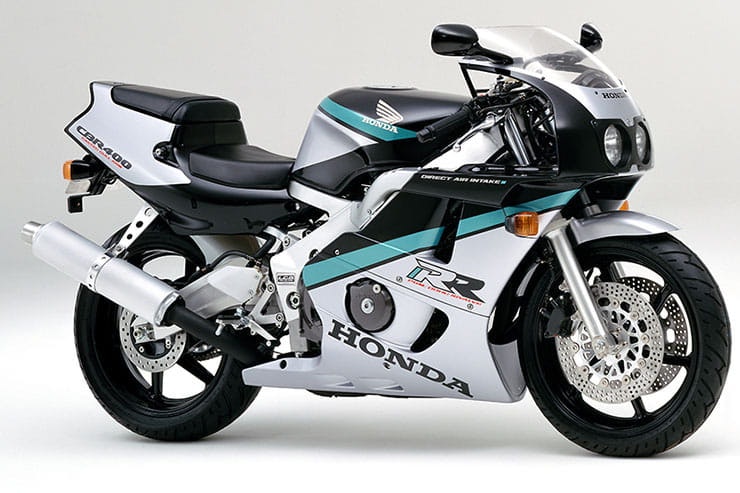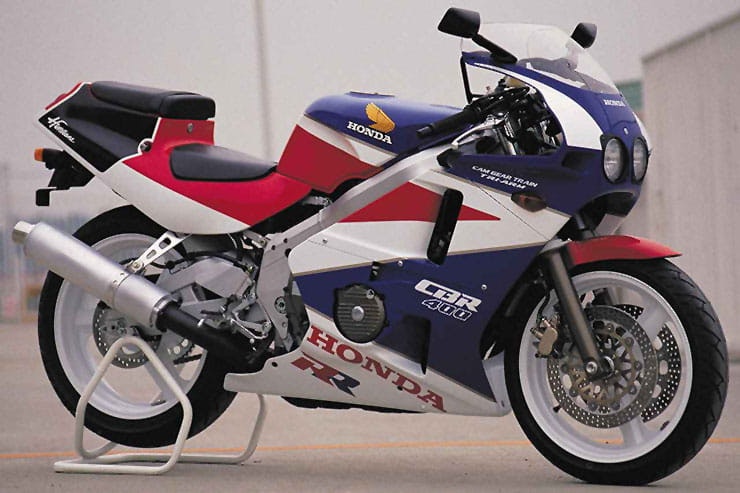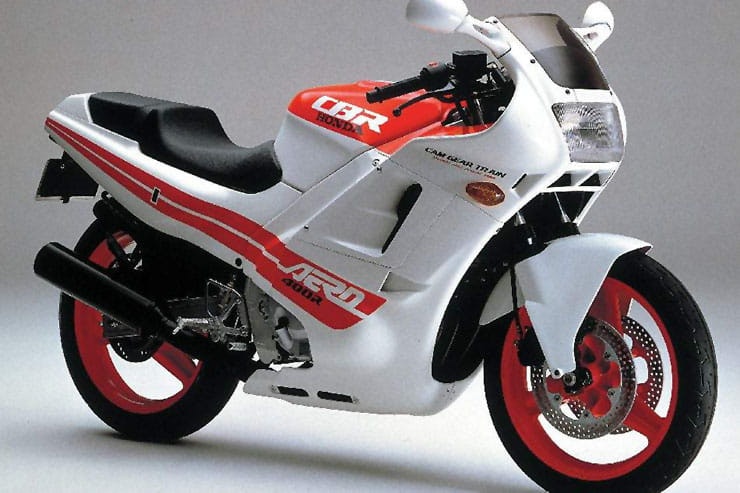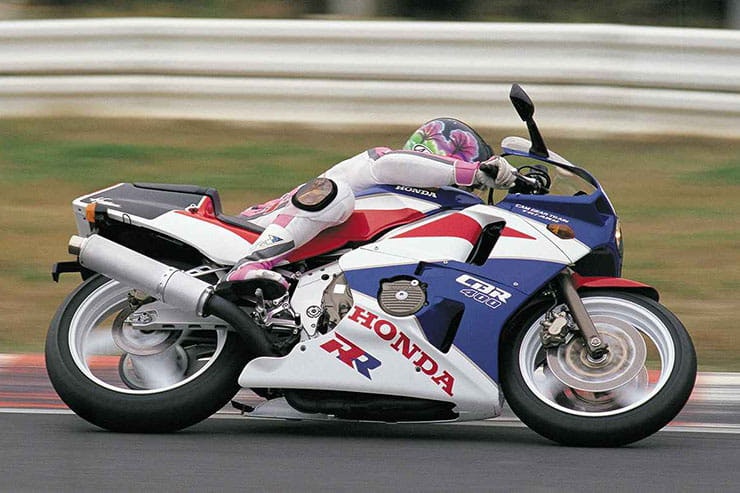Honda CBR400R/RR (1986-1994): Review & Buying Guide
By Jim Moore
Bike journo for a quarter of a century
22.08.2023
Price: £3000-£6000 | Power: 59bhp | Weight: 163kg | Overall BikeSocial Rating: 4/5
You don’t have to spend a fortune to own an exotic, beautifully engineered jewel of a machine that’s on the cusp of becoming a bona fide modern classic. Honda’s exquisite CBR400R/RRs are all of the above and more, yet you could have an outstanding example of the breed in your garage for as little as £3000.
These miniature superbikes come from a time when excess was everything and only the trickest, most advanced engineering, technology and styling guaranteed sales success. The CBR400 is a product of Japan’s then gluttonous domestic market – an insatiable whirlwind of consumer spending and capitalist desire where the need to own the brightest, newest, flashiest machine available was what really mattered.
The other driver was Japanese law. Gaining a licence to ride anything bigger than 400cc required a process so complicated and expensive that most riders didn’t bother moving up. So, the largest capacity machines they could ride had to be special. And Honda’s CBR400s, from the original 1986 400R Aero (a downsized yet technically superior clone of the more familiar CBR600F) through to the still achingly beautiful CBR400RR Gull-Arm, were – and still are – very special indeed.
Some 400s were sold into the UK through official channels (Kawasaki’s ZXR400L and Yamaha’s FZR400RR shifting the most units), but most made it here through grey importers, and CBR400RRs were big sellers. Although not as powerful as 600s, these Honda 400s can rev to a heady 14,500rpm, and nudge 130mph on just shy of 60bhp. Crucially, however, they are way tricker than any 600 of the period (and even some litre bikes for that matter…), boasting all-aluminium chassis, endurance racing inspired styling and a level of finish and detailing that’s more factory race shop than mass production line.
Three decades on these 400s still set the standard for the capacity in terms of tech and performance and, because of their modest size, they’re still a big hit with young and first time riders as well as fanatics and collectors. Here’s how to find a good ’un.
Honda CBR400R/RR (1986-1994) Price
Three distinct models make up the CBR400R/RR family – the 1986-’87 CBR400R Aero, ’88-’89 CBR400RR Tri-Arm, and the 1990-’94 CBR400RR Gull-Arm. All models were produced for the Japanese domestic market so, consequently, these mini superbikes were exquisitely engineered to boost appeal to a massive audience.
Once three years old, all bikes in Japan are subject to a rigorous and prohibitively expensive MoT style inspection. Most owners simply trade-in for a newer model. In the 1980s and ’90s this left a huge glut of barely used, extremely trick, yet cheap 400 race reps that were then snapped up by grey import dealers across Europe. In the UK, this created a market of exotic, affordable sports bikes that proved hugely popular with new riders. Honda’s CBR400, often called the ‘Baby Blade’, was a particular favourite.
CBR400R Aero values: Rough £1000-£1500; Tidy £1800-£2500; Mint £2800-£3200
First-gen ‘Jellymould’ CBR600F clone, sold in Japan between 1986-’87. Model code NC23. All-aluminium perimeter chassis, 399cc, DOHC, 16v inline-four engine with gear-driven cams, 59bhp@12,500rpm, 165kg. Not to be confused with older, air-cooled CBR400F and Endurance models. Faired-in indicators front and rear. Colours: red/white, blue/white, red/white/blue, black/graphite/red.
CBR400RR Tri-Arm values: Rough £1500-£2000; Tidy £2500-£3200; Mint £3500-£4000
Although the Tri-Arm shares the Aero’s engine and NC23 model code, this first RR is a radically different model. All new aluminium beam frame and braced swingarm (hence Tri-Arm). Wider 120/60 x 17 and 150/60 x 18 rubber and three-spoke wheels. RC30 type endurance styling with twin headlamps and single-style seat (there is minimal pillion accommodation). 59bhp@12,5000rpm, 162kg. Colours: red/white/blue, black/gold/graphite, blue/white.
CBR400RR Gull-Arm: Rough £1800-£2500; Tidy £3000-£4500; Mint £5000-£6000
NC29 model code. Minor updates to engine, but everything else changed. New – and slightly odd looking – two-tier aluminium perimeter chassis, banana-style swingarm (known as ‘Gull-Arm’), six-spoke wheels – the rear now 17in, FireBlade type styling. 59bhp@12,500rpm from 1990-’93; 1994 model restricted to 53bhp to meet Japanese law. Colours: black/turquoise/silver, red/white/blue, black/pink, black/graphite, red/white/blue FireBlade graphics.
Beautifully engineered – still head and shoulders above any modern 400
Sweet handling; get the soft suspension overhauled and hunt down corners
Still great value compared to 250 two-strokes
Getting harder to find a mint, unmolested examples
60bhp is as good as it gets
Modest size is great for small riders, but no good if you’re bigger
Honda CBR400R/RR (1986-1994) Engine and Performance
CBR denotes an inline-four Honda. The first model to use the name was another Japan-only creation, the 1983-’85 CBR400F, an air-cooled four housed in a box-section steel perimeter chassis. Essentially a development of the CBX400, it gained variable-valve-timing to give it a technical edge. But being air-cooled its life span was always going to be limited.
Its replacement, the ’86 400R Aero, featured an all-new liquid-cooled inline-four. Sharing the same 55 x 42mm bore and stroke as the 400F gave the Aero a displacement of 399cc, but its motor was much more compact. New pistons increased compression from 9.6:1 to 11.0:1 while forward canted cylinders allowed the use of downdraught type 26mm flatslide CV Keihin carbs to feed the 16v DOHC top end.
The use of gear-driven cams – previously the preserve of Honda’s racing V4s and top sportsbikes, like the VF1000R, VFR750F and later the RC30 – did away with the need for a camchain, further reducing the width of the motor, although variable valve timing was not part of the package. A lightly tweaked variant of the same motor made its way into the 1988 CBR400RR Tri-Arm; compression was increased slightly to 11.3:1, a new ram-air system to force feed the airbox was also employed along with a revised 4-1 exhaust. Peak power and torque remained the same at 59bhp @ 12,500rpm and 28.7 lb.ft @ 10,000rpm.
Delivery is understandably peaky, revving to 14,500rpm if required, but both NC23 units are remarkably tractable despite making less than 30lb.ft at peak. The NC29 Gull-Arm uses a further development of the same engine, with further piston updates, a new exhaust and improved cooling. Peak torque is up slightly to 28.8 lb.ft, again at 10,000rpm.
Honda CBR400R/RR (1986-1994) Handling & Suspension
While more familiar middleweight 600s were built down to a price with steel chassis and solid rather than cutting edge tech, Japanese market 400s benefitted from the very best engineering each manufacturer could muster. Starting with the CBR400R Aero, Honda created an all-aluminium perimeter frame and box-section swingarm, although most of it was hidden behind all-enclosed bodywork. Three-spoke cast wheels, sliding caliper brakes, TRAC-anti-dive equipped forks and Showa monoshock aped those of the CBR600F, right down to the 18in rear wheel.
The NC23 Tri-Arm is a radically different animal. Styled to mimic an endurance racer of the time, with twin front and rear lights, under-yoke clip-ons, a deep-sided beam frame and triangularly braced swingarm (hence Tri-Arm), 41mm preload adjustable forks and a preload/compression damping adjustable shock, the CBR400RR was a pukka sports bike in every sense of the word. Wider rims allowed more generous 120/60 17 and 150/60 18 rubber than the Aero, too. Handling is sweet and precise, although damping is on the soft side and the 18-in rear wheel limits tyre choice.
It was all change again with the NC29 Gull-Arm. The frame, a strange two-tier beam design inspired by the one used on Honda’s full factory RCB400 TT-F3 racer, aimed to lower the bike’s centre of gravity (the L.C.G. acronym on the frame casting stands for Low Centre Gravity), while a banana style swingarm allows the exhaust to sit higher for improved ground clearance. As with the Tri-Arm, only the softly damped suspension spoils the handling, but that’s a relatively easy fix.
Honda CBR400R/RR (1986-1994) What to look for
Spares: Parts for Tri-Arms and Gull-Arms are still easy to find – so many bikes were brought in during the 1990s, and subsequently broken, that finding spares is easier than with some grey imports. That said, decent bodywork is getting thin on the ground. Some parts, like discs, calipers, front wheels (NC29), switchgear and lights are common with other Hondas, so check parts numbers. Aero NC23 parts are harder to find, so if you buy one make sure it’s complete. Very few CBR600 parts are interchangeable with the Aero. Long established grey import experts, like Fastline Superbikes in Preston (01772 902600), are your friends here.
Exhaust: The mild steel headers on all models rot from the inside out. Replacements are hard to find – especially aftermarket – so inspect thoroughly. If you’re lucky, you’ll find a CBR already fitted with a quality Japanese 4-1 system. If you retro-fit a 4-1, jet the carbs to suit because Japanese market bikes are often jetted lean from the factory.
Reg/Rec: Most Hondas of this vintage suffer from premature reg/rec failure (the author’s own CBR400R suffered just such a fate back in 1994 – symptoms usually start with dimming lights before complete electrical failure grinds the bike to a halt). Replacements are affordable (£90 from ) and easy to fit. If your prospective purchase is still running its original unit, expect to have to change it sooner rather than later. Wiring looms will be getting old now, too. Cleaning earthing points is good practice – most electrical gremlins start from poor earths.
Suspension: CBR400s were built for the Japanese market where consumers are generally smaller and lighter than us Europeans, so the suspension is on the soft side. Add 30 years of use to the mix and any NC23/29’s forks and shock will, by now, benefit from firmer damping. Quality aftermarket shocks are available, Nitron’s R1 unit (from £525) being an excellent choice.
Engine: With gear-driven cams and four 99.75cc pistons, every CBR400 motor is a jewel-like wonder. A 14,500rpm redline makes them hard working units, too. Despite this, reliability is excellent and 50,000 trouble-free miles is well within grasp. Longevity and reliability is entirely dependant on meticulous servicing, however. Oil and filter should be changed every 3000 miles (max) – a quality semi-synth will do the trick. Spark plugs aren’t cheap – up to a tenner each, so £40 a set, is normal. Gearboxes and clutches are generally robust, but check second gear. If it drops out of gear under load you could be looking at a replacement selector fork or worn engagement dogs. Either way, it’s a time consuming and potentially costly engine strip.
Restrictions: Japanese imports of this era were all speed restricted to 180kph (112mph). Bypassing the limiter is easy – there’s a peg inside the speedo that, when triggered by the speedo needle at 180kph, cuts the ignition. Remove the peg to do away with the restriction, or fit a kph-to mph plug in to the back of the speedo. Either modification works. Post ’93 Gull-Arms are further restricted to 53bhp. Fitting an earlier CDI unit removes the restriction.
Honda CBR400R/RR (1986-1994) Rivals
The Japanese 400cc supersport market was huge during the 1980s and ’90s, reflected by a numerous models released by the big four on a pretty much bi-annual basis. As well as producing the delectable CBR400, Honda also built V4s – VF, VFR and RVF. The latter two, NC30 and NC35, are direct rivals for the inline CBRs, offering the same exquisite engineering and build quality, along with V4 character. But there are rivals from Kawasaki, Suzuki and Yamaha too, the best being the models below.
Yamaha FZR400RR, 1992 | Approx Price: £2000-£4000 (up to £7000 for SP)
Power/Torque: 66bhp/28.9lb-ft | Weight: 162kg
The 400RR was officially imported to the UK in 1992. Claimed power (66bhp) is a touch higher than Japanese spec. Great handling, fun to ride – sharp chassis, strong motor with EXUP exhaust valve. SP version with close-ratio ’box, better suspension and single seat also available; expect to pay more (up to £1000-£1500) for this model.
Suzuki GSX-R400RR, 1990 | Approx Price: £2000-£4000 (up to £5000 for SP)
Power/Torque: 60bhp/28.3lb-ft | Weight: 167kg
The GK76 model has fabulous handling and a peaky motor that begs to be revved. Build quality is hit and miss – paint finish, plating and plastics can get tatty quite quickly. Styling apes that of the GSX-R750 endurance racer. SP model also available, with fully adjustable suspension, close-ratio gearbox etc.
Kawasaki ZXR400L, 1990 | Approx Price: £2500-£4500
Power/Torque: 62bhp/26lb-ft | Weight: 160kg
Another 400 race replica imported into the UK (from 1990 as the L model – previous H model is a grey import only, as are both SP models). Gorgeous styling, sweet steering but harsh damping, particularly at the rear, spoils the ride. Engine lacks the character of the CBR’s. The large pool of used examples is helpful, however.
Honda CBR400R/RR (1986-1994) Verdict
Honda built the best 400 race replicas, by far. Only Yamaha’s full-on FZR400RR SP EXUP comes close, but it needs all its Sports Production extras to get close to either a CBR Gull-Arm or an NC30. The fact that the CBR400RR – both NC23 and NC29 – are better engineered, better built, faster and way more exciting to ride than any modern Japanese machine of the same capacity speaks volumes about how far advanced they were when they first came out. They’ve not only stood the test of time, they’re also still the high-water mark for the capacity. Find a tidy CBR400 and have a piece of mini exotica to cherish and enjoy. But buy one now before the values go the way of 250 two-strokes…
Honda CBR400RR (1994) – Technical Specification
If you’d like to chat about this article or anything else biking related, join us and thousands of other riders at the Bennetts BikeSocial Facebook page.
Looking for motorcycle insurance? Get a quote for this motorbike with Bennetts bike insurance



